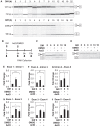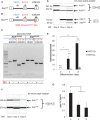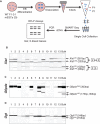Developmental Xist induction is mediated by enhanced splicing
- PMID: 30496473
- PMCID: PMC6379716
- DOI: 10.1093/nar/gky1198
Developmental Xist induction is mediated by enhanced splicing
Abstract
X-inactive-specific transcript (Xist) is a long noncoding RNA (lncRNA) essential for inactivating one of the two X chromosomes in mammalian females. Random X chromosome inactivation is mediated by Xist RNA expressed from the inactive X chromosome. We found that Xist RNA is unspliced in naïve embryonic stem (ES) cells. Upon differentiation, Xist splicing becomes efficient across all exons independent of transcription, suggesting interdependent or coordinated removal of Xist introns. In female cells with mutated polypyrimidine tract binding protein 1 (Ptbp1), differentiation fails to substantially upregulate mature Xist RNA because of a defect in Xist splicing. We further found both Xist129 and XistCAS RNA are unspliced in Mus musculus 129SvJ/Mus castaneous (CAS) hybrid female ES cells. Upon differentiation, Xist129 exhibits a higher splicing efficiency than XistCAS, likely contributing to preferential inhibition of the X129 chromosome. Single cell analysis shows that the allelic choice of Xist splicing is linked to the inactive X chromosome. We conclude post-transcriptional control of Xist RNA splicing is an essential regulatory step of Xist induction. Our studies shed light on the developmental roles of splicing for nuclear-retained Xist lncRNA and suggest inefficient Xist splicing is an additional fail-safe mechanism to prevent Xist activity in ES cells.
© The Author(s) 2018. Published by Oxford University Press on behalf of Nucleic Acids Research.
Figures




Similar articles
-
CRISPR/Cas9-mediated modulation of splicing efficiency reveals short splicing isoform of Xist RNA is sufficient to induce X-chromosome inactivation.Nucleic Acids Res. 2018 Mar 16;46(5):e26. doi: 10.1093/nar/gkx1227. Nucleic Acids Res. 2018. PMID: 29237010 Free PMC article.
-
Xist RNA repeat E is essential for ASH2L recruitment to the inactive X and regulates histone modifications and escape gene expression.PLoS Genet. 2017 Jul 7;13(7):e1006890. doi: 10.1371/journal.pgen.1006890. eCollection 2017 Jul. PLoS Genet. 2017. PMID: 28686623 Free PMC article.
-
Live cell imaging of the nascent inactive X chromosome during the early differentiation process of naive ES cells towards epiblast stem cells.PLoS One. 2014 Dec 29;9(12):e116109. doi: 10.1371/journal.pone.0116109. eCollection 2014. PLoS One. 2014. PMID: 25546018 Free PMC article.
-
Dynamic interplay and function of multiple noncoding genes governing X chromosome inactivation.Biochim Biophys Acta. 2016 Jan;1859(1):112-20. doi: 10.1016/j.bbagrm.2015.07.015. Epub 2015 Aug 7. Biochim Biophys Acta. 2016. PMID: 26260844 Free PMC article. Review.
-
3D genomic regulation of lncRNA and Xist in X chromosome.Semin Cell Dev Biol. 2019 Jun;90:174-180. doi: 10.1016/j.semcdb.2018.07.013. Epub 2018 Jul 14. Semin Cell Dev Biol. 2019. PMID: 30017906 Review.
Cited by
-
Real-time PCR quantification of spliced X-box binding protein 1 (XBP1) using a universal primer method.PLoS One. 2019 Jul 22;14(7):e0219978. doi: 10.1371/journal.pone.0219978. eCollection 2019. PLoS One. 2019. PMID: 31329612 Free PMC article.
-
Intron detention tightly regulates the stemness/differentiation switch in the adult neurogenic niche.Nat Commun. 2024 Apr 2;15(1):2837. doi: 10.1038/s41467-024-47092-z. Nat Commun. 2024. PMID: 38565566 Free PMC article.
-
Roles of PTBP1 in alternative splicing, glycolysis, and oncogensis.J Zhejiang Univ Sci B. 2020 Feb.;21(2):122-136. doi: 10.1631/jzus.B1900422. Epub 2020 Feb 5. J Zhejiang Univ Sci B. 2020. PMID: 32115910 Free PMC article. Review.
-
PTBP1 Depletion in Mature Astrocytes Reveals Distinct Splicing Alterations Without Neuronal Features.bioRxiv [Preprint]. 2025 Jun 3:2025.05.30.657115. doi: 10.1101/2025.05.30.657115. bioRxiv. 2025. PMID: 40501814 Free PMC article. Preprint.
References
-
- Huynh K.D., Lee J.T.. Inheritance of a pre-inactivated paternal X chromosome in early mouse embryos. Nature. 2003; 426:857–862. - PubMed
-
- Mak W., Nesterova T.B., de Napoles M., Appanah R., Yamanaka S., Otte A.P., Brockdorff N.. Reactivation of the paternal X chromosome in early mouse embryos. Science. 2004; 303:666–669. - PubMed
-
- Monkhorst K., Jonkers I., Rentmeester E., Grosveld F., Gribnau J.. X inactivation counting and choice is a stochastic process: evidence for involvement of an X-linked activator. Cell. 2008; 132:410–421. - PubMed
-
- Lessing D., Anguera M.C., Lee J.T.. X chromosome inactivation and epigenetic responses to cellular reprogramming. Annu. Rev. Genomics Hum. Genet. 2013; 14:85–110. - PubMed
-
- Augui S., Nora E.P., Heard E.. Regulation of X-chromosome inactivation by the X-inactivation centre. Nat. Rev. Genet. 2011; 12:429–442. - PubMed

